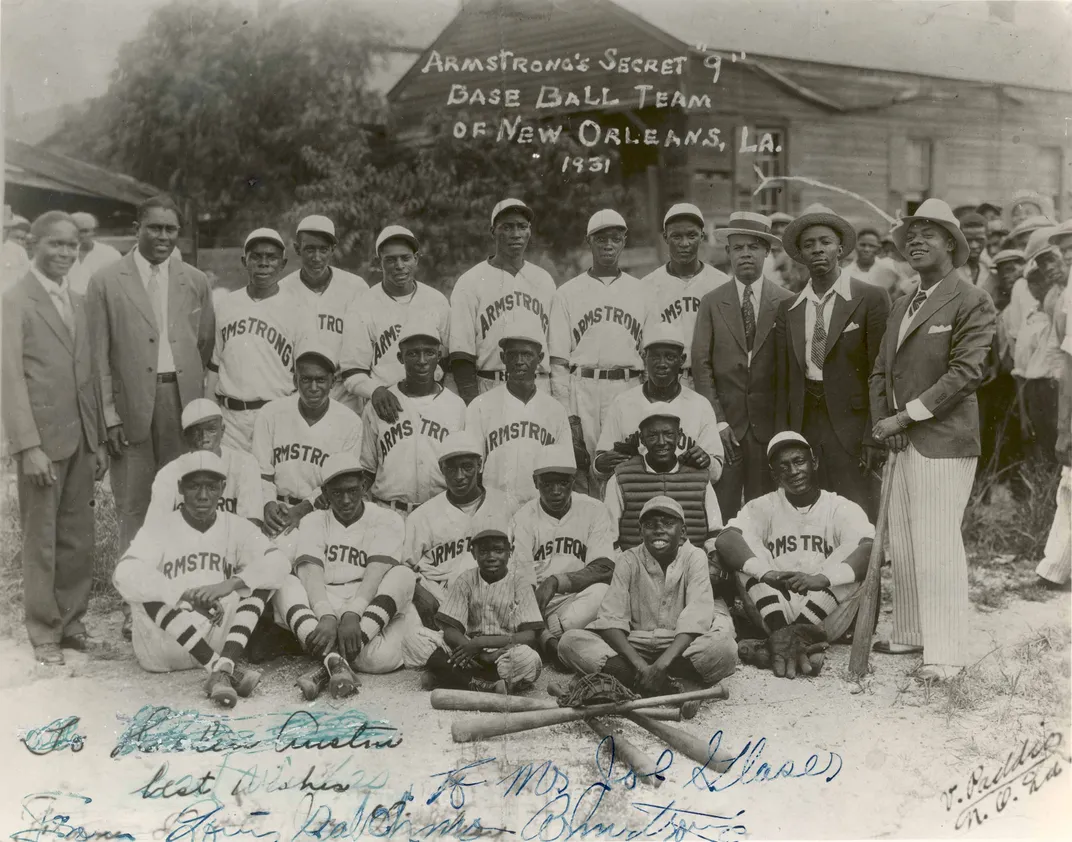Rare Footage of Duke Ellington Highlights When Jazz and Baseball Were in Perfect Harmony
The Smithsonian’s curator of American music explains how the history of two great American innovations—Jazz and baseball—are intertwined
:focal(701x398:702x399)/https://tf-cmsv2-smithsonianmag-media.s3.amazonaws.com/filer/df/b9/dfb9b354-5c5d-451d-be6b-be518b31ef67/c_brooks_ellington_smith_bb.jpg)
Essayist Gerald Early once said: “When they study our civilization two thousand years from now, there will only be three things that Americans will be known for: the Constitution, baseball and jazz music. They’re the three most beautiful things Americans have ever created.” Whether or not you agree with those words, the next time you hear the word swing, you can think of two great, iconic American innovations.
Baseball and jazz both use swing as a noun and a verb, and in both fields swing involves time and timing. “But on a deeper level,” observed trombonist Alan Ferber, “baseball players and jazz musicians both strive for a perfect balance between disciplined practice and spontaneity.”
Both the game and the music were born in the United States. And their influences are known around the world. The sound emanating from the crack of the bat is as well loved as the long, soulful wail of a tenor saxophone. And significantly, both players require years of preparation, frequent practice, teamwork, motor memory and a high level of skill and expertise. The two all-American pursuits share other happy, historic connections. Both pursuits have relied heavily on 20th-century communications media to win audiences. And both have spread to many other countries.
The very word jazz may owe its origins to baseball. The first documented use of the word—meaning pep, or energy and vigor—occurred in a 1913 newspaper article about the San Francisco Seals. "The poor old Seals have lost their 'jazz' and don't know where to find it," said the article. "It's a fact. . .that the 'jazz,' the pepper, the old life, has been either lost or stolen, and that the San Francisco club of today is made up of jazzless Seals."
From the earliest days of jazz in New Orleans, baseball was popular with musicians. In 1931, trumpeter Louis Armstrong played in his hometown of New Orleans for three months, he took an interest in a local sandlot team dubbed “The Raggedy Nine” and bought them new uniforms and equipment. In thanks, they renamed themselves “Louis Armstrong’s Secret Nine.” At their games, Armstrong would throw out the first pitch. The Secret Nine’s gleaming white uniforms, however, proved much more impressive than their ball skills—many of the players refused to slide for fear of getting dirty.
During jazz’s “Swing Era,” baseball reigned as “America’s pastime,” and baseball or softball teams formed within many bands, including those led by such big names as Benny Goodman, Count Basie, Harry James, Tommy Dorsey, and Duke Ellington. Trumpeter James was so passionate about playing baseball that according to his biographer Peter J. Levinson, James once asked a musician, “What do you play?” The musician replied, “What do I play? I play tenor saxophone and double on clarinet.” James said, “No, what position in baseball”? So that they could practice as they toured, James’s men made ball fields in cow pastures. His musicians not only played against other bands, they would divide into two opposing teams to play each other while on the road, or play college and prison teams along the way. James stored extra balls and bats and gloves on his band’s touring bus. And it was rumored, he actually kept a ringer on hand— a guy who could pitch, but who couldn’t play a single tune on any instrument.
Jazz bands would sometimes tour for as long as six months at a time, and the band leaders found playing a game of baseball would lift spirits. Cab Calloway’s big bands, suited up in their own baseball uniforms, would play ball opposite the local semi-pro teams and perform charity games in municipal stadiums. During their extensive travels, pianist-composer-bandleader Duke Ellington and his band members enjoyed playing the all-American sport as well.
The National Museum of American History’s vast Duke Ellington Collection even includes some home movies from about 1941 of Ellington and his cornetist Rex Stewart, who played with Ellington from 1935 to 1945, tossing and hitting the ball. In the film, it a treat to see Stewart taking his mighty, twirling swings (:08) and Ellington first pitching and then taking a swing (:15); then valve trombonist Juan Tizel pitches (:41) and finally tenor saxophonist Ben Webster is framed in a final shot on the train. A photo from the mid-1950s depicts Ellington holding a bat in front of his band’s touring bus, someplace in the south, with a nearby sign “Colored only” symbolizing the rigid racial segregation of the day. This month is designated as the Jazz Appreciation Month and the American History Museum will shine its spotlight on the music as both an "historical and living treasure."
A long fly ball to the outfielder in left is always a site to behold. Picture saxophonist Zoot Sims making the running catch, as he did, once while playing for Woody Herman’s band and ball club. Zoots reached up to snag the ball with his left hand, and as he did it, his hat flew off. But with the precise execution of a musician, Zoots caught the cap with his right.
Those jazz men. They sure got that swing.
/https://tf-cmsv2-smithsonianmag-media.s3.amazonaws.com/accounts/headshot/HasseJohnEdwardWEB.jpg)
/https://tf-cmsv2-smithsonianmag-media.s3.amazonaws.com/filer/c1/18/c118f9dc-0510-421f-ac42-c4be1c586315/20063979_catchers_mask_1957.jpg)
/https://tf-cmsv2-smithsonianmag-media.s3.amazonaws.com/filer/e7/28/e7288e93-a296-4492-8e48-87b321df8e56/20061847.jpg)
/https://tf-cmsv2-smithsonianmag-media.s3.amazonaws.com/filer/cd/56/cd56379c-231d-4271-953d-2bbe060eeb7f/scrapbook_2_baseball.jpg)
